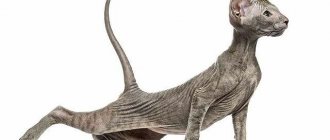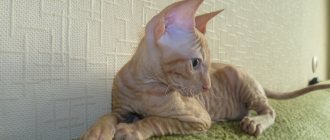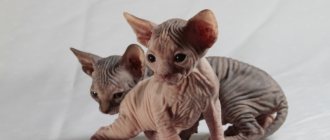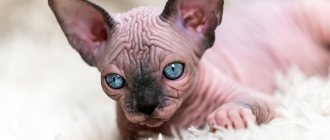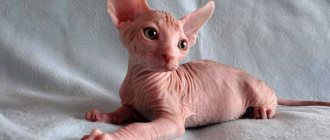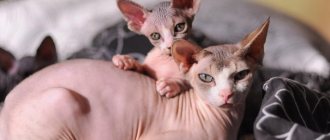Nowadays cats with a lack of hair will not surprise anyone. The current varieties of sphinxes evoke a smile, curiosity and a desire to touch the delicate skin of a hairless cat. But just twenty years ago, this breed evoked a mixture of horror and admiration.
Graceful animals with a mysterious look instantly captivated cat connoisseurs, and a boom swept across the planet, leading to the development of selective breeding. Attempts to breed a new species led to unexpected results.
By the way, these luxurious beauties are usually called not bald, but naked. Friendly pets with an exotic appearance have a good-natured character and an advantageous feature for people suffering from allergies is the lack of thick fur.
What does the Don Sphynx look like?
After looking at the photo of the Don Sphynx, one gets the impression that he has a lot in common with Egyptian cats. The size of representatives of this breed reaches 25-30 cm in height at the withers. How much a Donchak should weigh depends on gender - boys are always larger. They reach 5-7 kg. The weight of girls is more modest and amounts to 3.5-5 kg.
Muzzle
The breed is characterized by a wedge-shaped head with pronounced cheekbones and a strong-willed chin. On the rounded muzzle there is a straight nose, connected to the wrinkled forehead by a pronounced stop. On the top of the head are large, widely set ears, rounded at the tips.
The Donchak has slightly slanted, almond-shaped eyes that lack eyelashes. Short vibrissae are twisted into a spiral. They often break off, and sometimes they don’t grow back at all. Defects of the breed include a narrow or rounded head, too small ears, inversion of the eyelids and an underbite of more than 2 mm.
Body type
The low and thin neck goes into a dense and muscular body, expanding in the croup and chest. The front limbs of the Doncha are shorter than the hind limbs. They end in strong and powerful paws with elongated toes. The flexible, whip-like tail tapers to a tip. An abundance of folds is characteristic of the neck, armpits, paws, abdomen, groin area and tail.
Canadian Sphynx
The history of the Canadian Sphynx began twenty years earlier than the Don Sphynx, when in 1966 a hairless kitten was born to a domestic cat in Canada. Such phenomena have occurred before, among different nations, but babies without fur were considered a mutation and were discarded. Only the Canadian kitten interested breeders and became the progenitor of a new breed, which is called Sphynxes all over the world. In Russia, the word “Canadian” was added to the name so as not to be confused with Don and St. Petersburg.
Unlike the Don species, the mutation of the Canadian species is expressed by a recessive baldness gene. Most often, sphinxes retain thin remnants of hair behind the ears, on the tail, limbs or on the nose even into adulthood.
A slightly perceptible fuzz of the skin gives the feeling of suede. With age, the pile may become thicker.
Character of the breed
The Don Sphynx is affectionate, gentle, requiring care and communication. This is a completely non-aggressive animal, but touchy and vulnerable. The Sphynx Brush needs the owner's attention and loves to sit on a person's lap. He can be obsessive when petting him, but quickly realizes that the owner is busy and cannot pay attention to him.
By temperament, the Don Brush pet is sanguine. He is sociable, friendly, inquisitive, non-conflict. If he is not busy with an exciting activity or game, he dozes off in a cozy place.
The Don Sphynx is a wonderful partner for children's games. He willingly participates in children's undertakings, is patient with pampering, and will not allow himself to show aggression towards the child. The Sphinx's attitude towards other domestic animals is loyal and friendly. The pet is ready to share a home with large non-aggressive dogs, and with decorative rodents, and with birds.
Character and special habits of brushes
These cats can be characterized as playful and inquisitive. Over time, they become full-fledged members of the family. They choose one master or favorite for themselves, they always obey him unquestioningly, carrying out all his commands. They treat other people with warmth and good nature. Also, the Sphynx Brush is intelligent, but tends to be touchy. However, he is not vindictive. You should not punish this animal physically and psychologically.
Brushes can be called empaths, capable of sensing changes in a person’s mood. They react to this, trying to pity and cheer up the person. Cats love affection, all kinds of manifestations of tenderness, care, and attention to themselves. This breed is characterized by quickly getting used to a new place, observing all the requirements that the owners place on them. If the animal refuses to visit the tray assigned to it, you just need to move it to another place.
Sphynx kittens.
Straight-haired cats
Straight-haired Sphynx cats are covered with regular hair. They have straight mustaches. With age, the hair does not fall off; the fur remains forever.
Straight-haired cats are obtained by crossing Sphynxes with Siamese and Oriental breeds. They lack the hairless gene. Despite the presence of hair, straight-haired animals are classified as sphinxes. Their appearance, character and habits are characteristic of this breed of cats. The hair on the body is considered a heritage of Oriental cats.
Straight-haired animals are mainly found among Peterbalds, less often among Don Sphynxes. Sometimes kittens with fur are born to completely hairless individuals. This is due to failures in genetics.
This type of sphinx cannot take part in exhibitions. Straight-haired kittens are discarded from breeding. The presence of permanent hair is considered a deviation from breed standards.
Tendency to diseases
Don Sphynx cats are predisposed to the following genetic diseases:
- congenital entropion of the eyelids (treated surgically);
- microphthalmos - reduction in the size of the eyeball (vision deteriorates);
- syndrome of “falling asleep kittens” (due to underdevelopment of the thymus gland, babies die);
- curvature of the caudal spine, causing a number of other pathologies (problems of the skeletal system, underdevelopment of the intestines, etc.);
- nipple hyperplasia in cats (if drugs to suppress sexual desire were used);
- undershot - shortening of the lower jaw (affects quality of life);
- skin vasculitis (inflammation of the vascular walls of the skin).
Most often, Don people have skin problems caused by excessive production of sebaceous glandular secretions. These may be the following diseases:
- dermatitis;
- eczema;
- trichophytosis;
- acne.
Absolutely naked individuals are susceptible to skin diseases more often than those with fur.
Health
One of the most common health problems among Sphynx cats is obesity. Due to excess weight, cats become inactive, their joints and internal organs suffer. In this case, it is important not to overfeed the animal and accustom it to the feeding regime.
It is worth noting that Sphynx cats are the most susceptible to infections, so kittens must be vaccinated and regularly shown to a veterinarian. Mature animals get sick quite rarely, but even they have troubles: acne, skin rashes or vasculitis. Also common among Sphynxes are congenital entropion of the eyelids, damage to the spine and tail, and a short lower jaw.
But these four-legged animals can boast of a long lifespan - sphinxes live for about 13-15 years.
pros
Many owners note the friendly and easy-going nature of Sphynx cats with fur. Cats of this breed have the following advantages:
- lack of aggression;
- high intelligence;
- learning ability;
- good harmony with other species of animals;
- pickiness in food;
- cleanliness.
In addition, Sphynx cats with fur are considered healing cats. They have increased heat exchange, and the surface of the hair always remains hot. These animals can be used as living heating pads. They are extremely affectionate and love to cuddle up to the human body.
Diseases of the coat
Causes and symptoms
If a cat’s fur coat has stopped shining and is getting into clumps, then there is a possibility of developing a disease in its body.
If the care of the cat’s fur is correct, the animal is healthy, then the fur coat is smooth, thick, and shiny. If not properly maintained, the hair can become tousled, tangled, and unattractive. Various diseases also affect the appearance of a fur coat, among which the following are common in cats:
- hormonal disorders;
- allergy;
- helminthiasis;
- fungal skin diseases;
- congenital disorders;
- weakened immunity;
- viral or bacterial infection;
- dysfunction of the sebaceous glands;
- liver diseases, in which, in addition to deterioration in the quality of the coat, the mucous membrane becomes yellow.
Other reasons:
- pregnancy;
- molt season;
- uncontrolled use of certain groups of drugs;
- stress;
- elderly age.
Symptoms of wool disease are:
Symptoms such as dandruff and itching indicate problems with the coat.
- Tarnishing and profuse hair loss.
- The hairs are constantly whipped into dense tangles and hang in icicles.
- Dandruff and inflammation appear on the skin on the right and left sides.
- Worried about itching, redness.
- Body temperature rises.
- The animal becomes lethargic and drowsy.
Features of brush sphinxes
Why sphinxes grow hair remains a mystery to breeders and geneticists. No other features are noticeable in these animals. Physically, they are completely identical to naked and flocked, but in terms of character there may be discrepancies.
Don Brushes, like all other representatives of this breed of Sphynx cats, are friendly, curious and sociable. They are easy to train and get along well with other pets.
Peterbalds are related by blood to Oriental and Siamese cats. This genetic line not only conveyed the body structure typical of people from the Asian region, but also inherited character traits. St. Petersburg brushes sometimes become aggressive or offended. But this happens extremely rarely.
No other behavioral anomalies are observed in sphinxes of all breeds. People from different continents who have undergone natural mutations are very similar in behavior, habits and ability to communicate.
Who are sphinxes and what are they like?
Sphynxes are cats that have no fur on their bodies . The group of these hairless cats includes three breeds:
- Canadian Sphynx;
- Sphinx of the Don (Donchak);
- Sphinx of Petersburg (Peterbald).
The Sphynx is a group of breeds of hairless cats, during the breeding of which a natural mutation was fixed, leading to the absence of hair.
Donchak and Peterbald dogs can be different in the type of coat:
- bare-born - hair is completely absent;
- flock - sparse hairs up to 2 mm long;
- velor - short (up to 4 mm), soft and sparse pile;
- brush - hard, short and crimped fur.
One litter can contain both hairless and brushed kittens
Canadians have the appearance of hairlessness. Short, fine hairs may be present on the paws, outside of the ears, tail, and scrotum. The bridge of the nose should be covered with normal hair. On other parts of the body, the cover can vary from complete hairlessness to soft peach-like fluff no more than 2 mm long.
Petersburg brush (Peterbald)
Russian breed, in the selection of which Don cats took part. Just like their predecessors, these sphinxes are covered with curly hair and some of them remain in this form for the rest of their lives. The second half “undresses” not completely. In adult cats, dense growth is observed on the face, tail and may be on the paws. This option is called brush point due to the characteristic location of the hair at the ends of the body.
Velours
Velor cats have longer and fuller coats than flocked cats. The Velor Sphynx is born with velvet hair that is clearly visible to the touch. The length of the villi can reach up to 3 mm. Velor Peterbalds have longer hair on their paws, face and tail than on other parts of the body.
With age, hair follicles die off. Velor Don Sphynxes completely lose their hair. In adulthood, these cats appear completely hairless. Adult Peterbalds may still have remnants of hair on their paws and head.
Why do sphinxes have fur?
The appearance of new hair on an animal of this breed, or, conversely, its disappearance after the woolly kittens grow up, is associated with many factors. There will be no clear answer. The reasons may be the following:
- The appearance of hairiness is sometimes influenced by vaccinations;
- hormonal manifestations of the individual associated with bearing kittens;
- unsuccessful selection of feed;
- weather;
- castration.
If a litter has ideal parents, but one of the kittens was still born with hair, do not forget that he had great-grandparents who gave the baby hair.
In the end, the lack of fur only reduces the price of a kitten, but does not in any way affect its character, which is sweet and good-natured, like all sphinxes.
Sphynx brush colors
Brush Sphynx cats can have a wide variety of colors, among which the following types of colors are distinguished. There is a specially developed table of brush color codes in which you can see the identity of your kitten.
Sphynx color coding table.
Material on the topic: popular colors of the Scottish cat breed.
Plain
This type is also called solid color or solid color. With this type, the cat has a uniform color over its entire surface.
- White. This color is found in all cat breeds.
- Black. It can range from a deep rich color to gray, depending on the thickness of the coat.
- Blue. This color is a variation of the black color, but can be confused with it. To accurately determine the exact color of the animal, it is determined by the color on the stomach, eye rims, lips and testicles.
- Red. This color always has a tabby pattern. Sometimes this color can be confused with cream.
- Cream. A variety of red color.
- Pink sphinx.
Rare colors
These colors include various tortoiseshell colors, which are most often found in cats. There are different varieties of this color:
Sphinx Brush at three years old.
Black turtle - combination of red and black;
- Blue - a combination of cream and blue colors;
- Turtle cinnamon;
- Turtle cream;
- Turtle Lavender.
There are other colors of Sphynx brushes that are also common among these cats:
- Chocolate. This is one of the black color options. This color is considered rare and does not occur often in this breed.
- Lilac. A type of chocolate color, but in light shades. Also applies to rare colors.
- Particolors. This can be bicolor and calico and the so-called calico chintz. It is a combination of tortoiseshell color combined with white.
- Color point.
- Tabby. There are several varieties of this pattern - marble or classic, tiger.
Rarer and more expensive tabby colors, which are especially valued among breeders, are:
- brown tabby;
- silver tabby;
- blue tabby;
- red tabby;
- cream tabby;
- chocolate tabby;
- cinnamon tabby;
- lavender tabby;
- fawn tabby.
The type of color does not affect the length of the animal's coat; the average hair length does not exceed 5 mm. and may vary depending on the molting period and other influencing factors.
Brush sphinx.
Description and standard
Among breeding specialists, these cats are usually called hairless, not hairless. All these breeds are characterized by a high degree of friendliness and good nature. There are also many rumors and myths associated with this breed about their hypoallergenicity. However, this is just a myth, since they cause allergies just like other types of cats.
What should a brash sphinx look like?
Since the hair of this breed is weak or completely absent, all body imperfections are noticeable at first glance at the animal. The Brush Sphinx must have:
- stocky, strong body of medium size;
- developed paws with strong muscles;
- straight line between back and tail;
- tail proportional to the body, tapering to a rounded end;
- the toes are long and gathered into a ball;
- the head is wedge-shaped;
- pronounced arches above the eyebrows;
- the muzzle is short with characteristic wrinkles on the forehead and pronounced whisker pads;
- the ears are large, the tips are rounded;
- almond shaped eyes.
The cat's body has a large number of wrinkles and a small amount of fur, more like fluff. A cat may have hair on its paws, back, and tail, but by the age of two it goes away completely. The amount of wool in sphinxes is a variable value that changes depending on the time of year.
Sphynx kitten brush.
Why does the Sphynx begin to grow hair?
Sometimes such cats suddenly begin to grow hair. However, there are several reasons for this phenomenon. With the arrival of autumn and winter, the cat begins to become covered with short, soft fluff. In some areas it may even be of sufficient length. This can happen even if it only gets cold outside the window, but the apartment is still warm. This is due to the influence of the biological calendar.
Another reason for this is hormonal changes. The fur may grow or, conversely, fall off. Changes occur during estrus, pregnancy, castration/sterilization, and disturbances in the functioning of internal organs. Hair may also fall out due to improper feeding, stress, change of place of residence and other reasons that may affect the animal.
Interesting things about sphinxes
- The hypoallergenic nature of Sphynx dogs is a myth. Even in the absence of fur, the body of overly sensitive people can react to the animal’s sweat and salivation.
- Sphynxes stand out among the cat family not only for their fantastic appearance, but also for their canine character: kind, loyal, attached to their owner.
- Cats of this breed get along easily with any pet, but if they were allowed to choose companions, they would prefer Sphynx cats.
- Sphynxes have a high heat output, so they love to eat heavily - only a fast metabolism saves them from obesity.
- Before the breed became known, owners tried to treat mutated hairless kittens for lichen.
- Cats love to sleep with their owners under the blanket, with their head on the pillow.
- Sphynx cats can sunbathe and sweat just like humans.
- Representatives of this breed live up to fourteen years, although there are cases where pets lived up to the age of nineteen.
Advantages and disadvantages of the breed
Sphinx brushes have many advantages. The most obvious of them are:
- these cats are always warm and very pleasant to hold;
- there is no need to comb the wool and constantly clean the apartment from wool;
- very gentle;
- loyal to their owner;
- lack of anger;
- inability to show aggression towards humans or animals;
- well trained;
- are quickly brought up;
- adapt well to new conditions;
- lifespan up to 19 years.
But there are also disadvantages, which include high appetite. Such cats are constantly hungry, which is explained by the peculiarities of heat exchange and metabolism. These cats produce a lot of sweat and need to be bathed frequently. The Sphinx can be called an interesting animal that requires special care.
Rules of care
These cats do not need serious care:
- Sphynx Brush cats are fed natural or premium dry food. Also, the cat’s body constantly needs a large amount of fluid and properly selected vitamins.
- Don't forget that the Sphynx Brush's ears and teeth need regular cleaning. Optimally - once a week.
- Brush cats need to be bathed regularly. You can buy a special product or take a good baby shampoo.
- Cats don't have eyelashes, so pay attention to their eyes. This is especially true for kittens - it is better to wipe their eyes with a damp, clean swab once a day.
Important! The hair of a plush Sphynx can change due to a new diet, temperature, humidity in the room, changes in hormonal levels during gestation or estrus.

